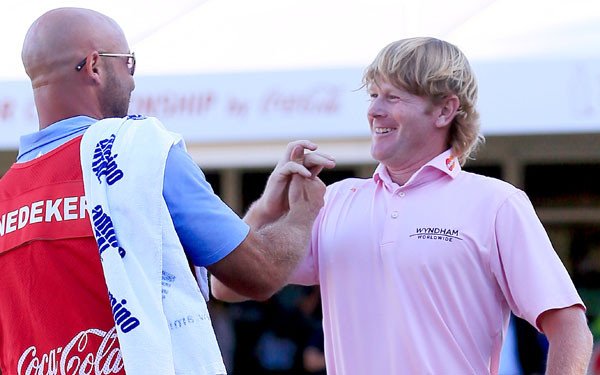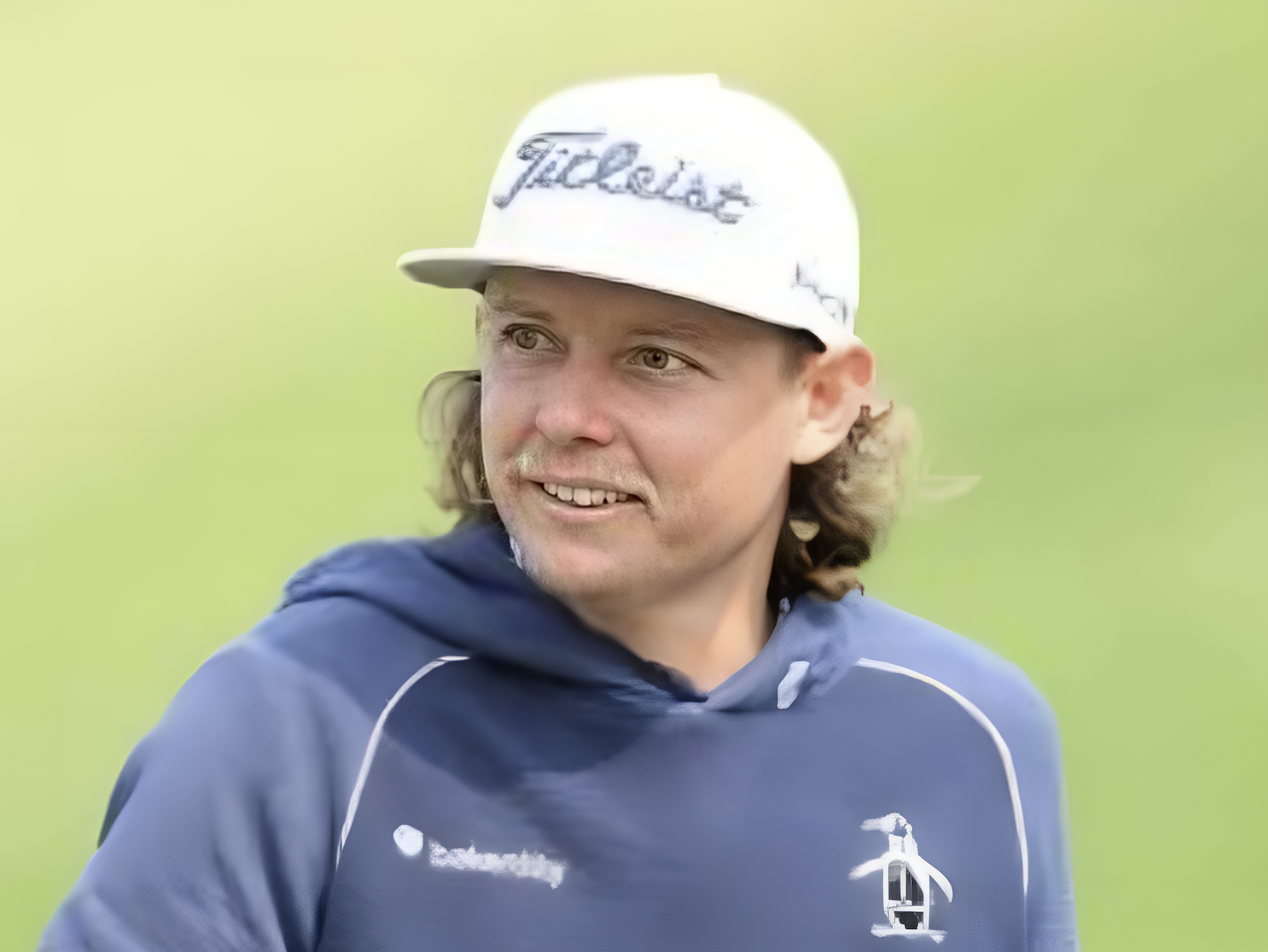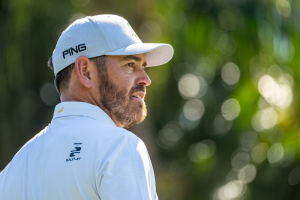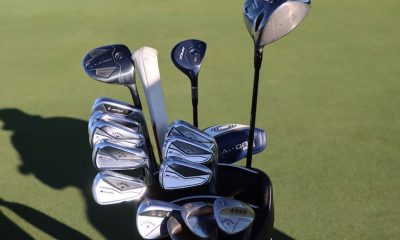Opinion & Analysis
In golf, perspective is more important than perfection

By Dennis de Jesus Jr.
GolfWRX Contributor
I’m a mid-handicap golfer who would love to be a single-digit or even a scratch. It’s not so I can join the tour and compete for the big (but often times small) purses of a tournament, it’s more of a badge of honor and to brag to friends that you can hit a dimpled ball pretty consistently and manage a decent round every once in a while. Anyone who is a casual golfer knows of someone who is a pretty solid golfer. He or she is that person who you want to be paired with for a scramble tournament and would only play for skins if they gave you a handful of generous strokes. I wanted to be that person – a guy that can run with the low handicappers and be somewhat envied by the mid-to-high handicappers.
But the reality is that I don’t practice or play enough to warrant such unreasonable expectations and I don’t have the natural talent to hide the imperfections (and there are many) in my game. But that doesn’t mean I’m not trying. A year ago, I decided to take lessons for the first time in my eleven year golf “career” because I really wanted it to be my goal to be that low digit handicapper that I’ve always dreamed about. So I packed my bags and went down to Palm Springs for a week of one-on-one sessions with a PGA Master Professional – a wizard who would presumably magically transform my swing from a weekend hacker into the rhythmic balance of Adam Scott. Turns out that to be Adam Scott you have to be born with some sort of physical gift that allows you the flexibility and length that he possesses. So a week of drills and many practice rounds later, I still had not perfected the golf swing, but I managed to take home with me a better tool set than I came with and improvements that actually helped lower my handicap a few strokes.
But with that kind of investment in time and money comes expectations and for whatever reason, I thought I could translate all that knowledge and good habits immediately and better my game by at least 10 or 11 strokes in the next season. Realistically, I probably improved about four-to-five strokes, but it didn’t feel like that was enough. I began to over think my swing and brought too much of the mental aspect into it, which as many of you know, is the harbinger of disaster when it comes to your golf game. With too much of my brain affecting my swing, I experienced a case of the dreaded —- (four letter y-word) and really tanked my game to a point where it wasn’t as fun anymore. I resigned to playing Tiger Woods on my PS3 to bring my confidence back, which would be similar to wearing a bandana tightly around your head to cure a migraine.
So there I was, less than a year removed from the excellent instruction I received from a PGA Master Professional, yet frustrated at the realization of sitting in the valley part of a roller coaster ride that is my golf game. I had already seen the improvements and I revelled in the little things that helped me go from being happy to have a 60-foot putt for birdie to actually seeing an approach shot as flag hunting. I knew it was a cyclical thing and often times getting out of the rut is a mind over matter, but I didn’t know what kind of trigger would help me this time around.
Almost by chance, I came across an advertisement from the local chapter of the Special Olympics looking for volunteers. I had been looking for a new volunteering opportunity around the same time, so the opportunity to work with such a respected organization already had my interest, but when they highlighted their need for coaches specifically in their golf program, I knew this would be a perfect fit for me.
My first day on the job wasn’t easy. We were asked to evaluate the athletes in a way that would allow the organizers to divide the group up into the various skill levels. This was the first time I was around golfers who had disabilities that limited their physical movement while others faced mental challenges which affected their motor skills. Up to that point, I was so critical of my own swing and those of my regular playing partners that I couldn’t quite grasp the concept of how imperfect the swings of these special athletes were. That first day was designed to just observe and judge and it was a struggle to do so objectively considering all the things I have been taught and conditioned to look for while watching golf telecasts and reading golf instruction books. Breaking plane, arms misaligned, bad grip, poor foot position, little shoulder turn — all the things that an instructor would cringe at were right in front of me. But in this environment, we celebrate the occasional good golf shot and encourage them to stay positive no matter what. To be honest, I think I was tough in my assessments of each athlete but at least I was consistent. As expected, each athlete had their own flawed swing all to their own and there wasn’t going to be a cure all drill or adjustment that would fix all of them at the same time.
Based on the assessments from the first day, each coach was assigned a handful of athletes that they would work with over the next two months on a weekly basis to develop a proper golf swing based on traditional instruction methods. Being a lefty, I was assigned the lefty athletes that were a mix of beginner (never swung a club) to intermediate (has played on a course a few times). Each week we worked on one component of the swing and then built upon that the following week, the intent being that by the end, the athletes are given the right tools and associated drills that would help them hit the ball more consistently and with more confidence. In essence, I would be teaching the golf swing from the ground up, starting from the basics all over again. In addition to teaching the sport to these eager athletes, this would be a nice refresher for myself because after a few years of being active in the sport, the basics can be quickly ignored in favor of bad habits and perhaps a reset was what I needed to get out of my rut.
It turns out the refresh of the golf swing mechanics was not what helped me. I thought that reviewing the basics of the “perfect” golf swing and teaching/learning it with these athletes would help me get over my own mental hurdle of the golf swing, as though repetition and teaching good habits out loud would trigger the proper swing thoughts even for myself. Nope — in fact it was witnessing the simple joy in the athletes when they occasionally hit the ball clean off the face and it would fly and go straight in the intended direction. Sure it might not have traveled an adequate distance for the club they had in their hand, but it was recognizing that it was a good golf shot versus a shank or a mishit. And a good golf shot was worth a high five.
My students also showed composure when they did mishit or miss the ball entirely. There was no swearing, no slamming the club to the ground, no club toss. They just reset, went through the prescribed pre shot routine and tried again. Not once did I hear any complaining from the athletes when I suggested an adjustment, even if the adjustment was physically impossible to achieve based on their disability. They still tried and allowed me to see how my suggestions would take or not, often times forcing me to make the adjustment.
Through it all, one thing remained constant – a good golf shot was welcomed and celebrated and a not so good one was quickly erased from memory until a solid shot was made again. This was all under the guise of athletes with less than perfect golf swings. Again, we can teach what an ideal setup is or what it means to be “on plane,” but the execution of it is usually less than ideal, even for an able bodied athlete.
Observing their composure and noting how to enjoy the simple success of a well hit golf shot helped me to appreciate the game as a whole again. I managed to take the intangible things I learned from working with these athletes onto the course and wouldn’t you know it, my game improved again. I began to see the game differently and instead of worrying about what I was doing wrong, I tuned my brain to believe in the shot I wanted to make and appreciating it more when it was well executed. I also learned to have a short memory with my bad shots and not dwell on them so much. I managed to stay relaxed throughout my round and just enjoy being out on the course regardless of how many circles/squares were on my card. And as an added benefit, my scores started to come down and I started to hover in the low-to-mid 80s, which is not bad for a hack like me. Obviously, there is still a lot of room for improvement and I’d like to be able to approach a round with breaking 80 in mind, but I think I’ve learned enough about perspective in the last few months that I won’t stress myself to get there.
Sometimes, it’s embracing imperfection that truly helps with one’s perspective. I didn’t need a sports psychologist or hours upon hours on the range to fix the mental block I created in my own mind. It was a simple matter of surrounding myself with the right mix of people with good attitudes and learning from them. I already received excellent professional instructions to fix the mechanics of my swing, but I overlooked the importance of the mental component of my game. It may seem strange that in addition to lessons, I learned how to play better golf by helping out disabled athletes who cannot physically or mentally build a perfect Ben Hogan-esque golf swing, but I can honestly say that what those athletes taught me about golf was more helpful than what Peter Kostis and the Swing Vision camera could ever do for me. I know I’m never going to be a pro golfer and I might even be hard pressed to be a scratch golfer, but I’m not going to resent the game because I’m unable to achieve those lofty goals. Instead, I’ll just enjoy my time on the course and high five my buddies every so often, even for a well-played double bogey.
Click here for more instruction in the “Golf Talk” forum.
- LIKE0
- LEGIT0
- WOW1
- LOL0
- IDHT0
- FLOP0
- OB0
- SHANK1
19th Hole
Vincenzi’s 2024 Zurich Classic of New Orleans betting preview

The PGA TOUR heads to New Orleans to play the 2023 Zurich Classic of New Orleans. In a welcome change from the usual stroke play, the Zurich Classic is a team event. On Thursday and Saturday, the teams play best ball, and on Friday and Sunday the teams play alternate shot.
TPC Louisiana is a par 72 that measures 7,425 yards. The course features some short par 4s and plenty of water and bunkers, which makes for a lot of exciting risk/reward scenarios for competitors. Pete Dye designed the course in 2004 specifically for the Zurich Classic, although the event didn’t make its debut until 2007 because of Hurricane Katrina.
Coming off of the Masters and a signature event in consecutive weeks, the field this week is a step down, and understandably so. Many of the world’s top players will be using this time to rest after a busy stretch.
However, there are some interesting teams this season with some stars making surprise appearances in the team event. Some notable teams include Patrick Cantlay and Xander Schauffele, Rory McIlroy and Shane Lowry, Collin Morikawa and Kurt Kitayama, Will Zalatoris and Sahith Theegala as well as a few Canadian teams, Nick Taylor and Adam Hadwin and Taylor Pendrith and Corey Conners.
Past Winners at TPC Louisiana
- 2023: Riley/Hardy (-30)
- 2022: Cantlay/Schauffele (-29)
- 2021: Leishman/Smith (-20)
- 2019: Palmer/Rahm (-26)
- 2018: Horschel/Piercy (-22)
- 2017: Blixt/Smith (-27)
2024 Zurich Classic of New Orleans Picks
Tom Hoge/Maverick McNealy +2500 (DraftKings)
Tom Hoge is coming off of a solid T18 finish at the RBC Heritage and finished T13 at last year’s Zurich Classic alongside Harris English.
This season, Hoge is having one of his best years on Tour in terms of Strokes Gained: Approach. In his last 24 rounds, the only player to top him on the category is Scottie Scheffler. Hoge has been solid on Pete Dye designs, ranking 28th in the field over his past 36 rounds.
McNealy is also having a solid season. He’s finished T6 at the Waste Management Phoenix Open and T9 at the PLAYERS Championship. He recently started working with world renowned swing coach, Butch Harmon, and its seemingly paid dividends in 2024.
Keith Mitchell/Joel Dahmen +4000 (DraftKings)
Keith Mitchell is having a fantastic season, finishing in the top-20 of five of his past seven starts on Tour. Most recently, Mitchell finished T14 at the Valero Texas Open and gained a whopping 6.0 strokes off the tee. He finished 6th at last year’s Zurich Classic.
Joel Dahmen is having a resurgent year and has been dialed in with his irons. He also has a T11 finish at the PLAYERS Championship at TPC Sawgrass which is another Pete Dye track. With Mitchell’s length and Dahmen’s ability to put it close with his short irons, the Mitchell/Dahmen combination will be dangerous this week.
Taylor Moore/Matt NeSmith +6500 (DraftKings)
Taylor Moore has quickly developed into one of the more consistent players on Tour. He’s finished in the top-20 in three of his past four starts, including a very impressive showing at The Masters, finishing T20. He’s also finished T4 at this event in consecutive seasons alongside Matt NeSmith.
NeSmith isn’t having a great 2024, but has seemed to elevate his game in this format. He finished T26 at Pete Dye’s TPC Sawgrass, which gives the 30-year-old something to build off of. NeSmith is also a great putter on Bermudagrass, which could help elevate Moore’s ball striking prowess.
- LIKE6
- LEGIT3
- WOW1
- LOL1
- IDHT0
- FLOP3
- OB1
- SHANK1
19th Hole
Vincenzi’s 2024 LIV Adelaide betting preview: Cam Smith ready for big week down under

After having four of the top twelve players on the leaderboard at The Masters, LIV Golf is set for their fifth event of the season: LIV Adelaide.
For both LIV fans and golf fans in Australia, LIV Adelaide is one of the most anticipated events of the year. With 35,000 people expected to attend each day of the tournament, the Grange Golf Club will be crawling with fans who are passionate about the sport of golf. The 12th hole, better known as “the watering hole”, is sure to have the rowdiest of the fans cheering after a long day of drinking some Leishman Lager.
The Grange Golf Club is a par-72 that measures 6,946 yards. The course features minimal resistance, as golfers went extremely low last season. In 2023, Talor Gooch shot consecutive rounds of 62 on Thursday and Friday, giving himself a gigantic cushion heading into championship Sunday. Things got tight for a while, but in the end, the Oklahoma State product was able to hold off The Crushers’ Anirban Lahiri for a three-shot victory.
The Four Aces won the team competition with the Range Goats finishing second.
*All Images Courtesy of LIV Golf*
Past Winners at LIV Adelaide
- 2023: Talor Gooch (-19)
Stat Leaders Through LIV Miami
Green in Regulation
- Richard Bland
- Jon Rahm
- Paul Casey
Fairways Hit
- Abraham Ancer
- Graeme McDowell
- Henrik Stenson
Driving Distance
- Bryson DeChambeau
- Joaquin Niemann
- Dean Burmester
Putting
- Cameron Smith
- Louis Oosthuizen
- Matt Jones
2024 LIV Adelaide Picks
Cameron Smith +1400 (DraftKings)
When I pulled up the odds for LIV Adelaide, I was more than a little surprised to see multiple golfers listed ahead of Cameron Smith on the betting board. A few starts ago, Cam finished runner-up at LIV Hong Kong, which is a golf course that absolutely suits his eye. Augusta National in another course that Smith could roll out of bed and finish in the top-ten at, and he did so two weeks ago at The Masters, finishing T6.
At Augusta, he gained strokes on the field on approach, off the tee (slightly), and of course, around the green and putting. Smith able to get in the mix at a major championship despite coming into the week feeling under the weather tells me that his game is once again rounding into form.
The Grange Golf Club is another course that undoubtedly suits the Australian. Smith is obviously incredibly comfortable playing in front of the Aussie faithful and has won three Australian PGA Championship’s. The course is very short and will allow Smith to play conservative off the tee, mitigating his most glaring weakness. With birdies available all over the golf course, there’s a chance the event turns into a putting contest, and there’s no one on the planet I’d rather have in one of those than Cam Smith.

Louis Oosthuizen +2200 (DraftKings)
Louis Oosthuizen has simply been one of the best players on LIV in the 2024 seas0n. The South African has finished in the top-10 on the LIV leaderboard in three of his five starts, with his best coming in Jeddah, where he finished T2. Perhaps more impressively, Oosthuizen finished T7 at LIV Miami, which took place at Doral’s “Blue Monster”, an absolutely massive golf course. Given that Louis is on the shorter side in terms of distance off the tee, his ability to play well in Miami shows how dialed he is with the irons this season.
In addition to the LIV finishes, Oosthuizen won back-to-back starts on the DP World Tour in December at the Alfred Dunhill Championship and the Mauritus Open. He also finished runner-up at the end of February in the International Series Oman. The 41-year-old has been one of the most consistent performers of 2024, regardless of tour.
For the season, Louis ranks 4th on LIV in birdies made, T9 in fairways hit and first in putting. He ranks 32nd in driving distance, but that won’t be an issue at this short course. Last season, he finished T11 at the event, but was in decent position going into the final round but fell back after shooting 70 while the rest of the field went low. This season, Oosthuizen comes into the event in peak form, and the course should be a perfect fit for his smooth swing and hot putter this week.

- LIKE12
- LEGIT3
- WOW0
- LOL1
- IDHT0
- FLOP1
- OB1
- SHANK1
Opinion & Analysis
The Wedge Guy: What really makes a wedge work? Part 1

Of all the clubs in our bags, wedges are almost always the simplest in construction and, therefore, the easiest to analyze what might make one work differently from another if you know what to look for.
Wedges are a lot less mysterious than drivers, of course, as the major brands are working with a lot of “pixie dust” inside these modern marvels. That’s carrying over more to irons now, with so many new models featuring internal multi-material technologies, and almost all of them having a “badge” or insert in the back to allow more complex graphics while hiding the actual distribution of mass.
But when it comes to wedges, most on the market today are still single pieces of molded steel, either cast or forged into that shape. So, if you look closely at where the mass is distributed, it’s pretty clear how that wedge is going to perform.
To start, because of their wider soles, the majority of the mass of almost any wedge is along the bottom third of the clubhead. So, the best wedge shots are always those hit between the 2nd and 5th grooves so that more mass is directly behind that impact. Elite tour professionals practice incessantly to learn to do that consistently, wearing out a spot about the size of a penny right there. If impact moves higher than that, the face is dramatically thinner, so smash factor is compromised significantly, which reduces the overall distance the ball will fly.
Every one of us, tour players included, knows that maddening shot that we feel a bit high on the face and it doesn’t go anywhere, it’s not your fault.
If your wedges show a wear pattern the size of a silver dollar, and centered above the 3rd or 4th groove, you are not getting anywhere near the same performance from shot to shot. Robot testing proves impact even two to three grooves higher in the face can cause distance loss of up to 35 to 55 feet with modern ‘tour design’ wedges.
In addition, as impact moves above the center of mass, the golf club principle of gear effect causes the ball to fly higher with less spin. Think of modern drivers for a minute. The “holy grail” of driving is high launch and low spin, and the driver engineers are pulling out all stops to get the mass as low in the clubhead as possible to optimize this combination.
Where is all the mass in your wedges? Low. So, disregarding the higher lofts, wedges “want” to launch the ball high with low spin – exactly the opposite of what good wedge play requires penetrating ball flight with high spin.
While almost all major brand wedges have begun putting a tiny bit more thickness in the top portion of the clubhead, conventional and modern ‘tour design’ wedges perform pretty much like they always have. Elite players learn to hit those crisp, spinny penetrating wedge shots by spending lots of practice time learning to consistently make contact low in the face.
So, what about grooves and face texture?
Grooves on any club can only do so much, and no one has any material advantage here. The USGA tightly defines what we manufacturers can do with grooves and face texture, and modern manufacturing techniques allow all of us to push those limits ever closer. And we all do. End of story.
Then there’s the topic of bounce and grinds, the most complex and confusing part of the wedge formula. Many top brands offer a complex array of sole configurations, all of them admittedly specialized to a particular kind of lie or turf conditions, and/or a particular divot pattern.
But if you don’t play the same turf all the time, and make the same size divot on every swing, how would you ever figure this out?
The only way is to take any wedge you are considering and play it a few rounds, hitting all the shots you face and observing the results. There’s simply no other way.
So, hopefully this will inspire a lively conversation in our comments section, and I’ll chime in to answer any questions you might have.
And next week, I’ll dive into the rest of the wedge formula. Yes, shafts, grips and specifications are essential, too.
- LIKE32
- LEGIT7
- WOW1
- LOL1
- IDHT2
- FLOP3
- OB1
- SHANK3
-

 19th Hole2 weeks ago
19th Hole2 weeks agoDave Portnoy places monstrous outright bet for the 2024 Masters
-

 19th Hole2 weeks ago
19th Hole2 weeks agoTiger Woods arrives at 2024 Masters equipped with a putter that may surprise you
-

 19th Hole1 day ago
19th Hole1 day ago‘Absolutely crazy’ – Major champ lays into Patrick Cantlay over his decision on final hole of RBC Heritage
-

 19th Hole3 weeks ago
19th Hole3 weeks agoReport: Tiger Woods has ‘eliminated sex’ in preparation for the 2024 Masters
-

 19th Hole1 week ago
19th Hole1 week agoTwo star names reportedly blanked Jon Rahm all week at the Masters
-

 19th Hole2 days ago
19th Hole2 days agoJustin Thomas on the equipment choice of Scottie Scheffler that he thinks is ‘weird’
-

 19th Hole1 week ago
19th Hole1 week agoReport: LIV Golf identifies latest star name they hope to sign to breakaway tour
-

 19th Hole1 week ago
19th Hole1 week agoNeal Shipley presser ends in awkward fashion after reporter claims Tiger handed him note on 8th fairway















Binx Watts
Oct 7, 2012 at 5:56 pm
What a great article and what wonderful insights you had! As the golf professional at a course in Elkridge, Maryland, I often comment that golf can be enjoyed on many levels…from beginner to pro.
I’ve felt the same elation while teaching students with physical limitations such as those in the Special Olympics. There’s nothing better than seeing the joy in their eyes after a shot they consider successful.
You and I have experienced first-hand the wisdom of the cliche’: one shot at a time. Congratulation!
Binx Watts
The Timbers at Troy G.C.
Dennis de Jesus Jr.
Jan 21, 2013 at 2:40 pm
Thanks very much for your kind words. It truly is amazing when you are reminded of the simple joys that sport can provide and more so when you are able to help make it a positive contribution. I have definitely learned to appreciate the sport a lot more through this experience and hope I can continue to help and encourage more students to pick up golf as a hobby. Thanks to you as well for growing the sport in your area!